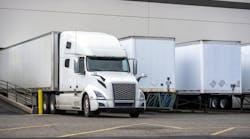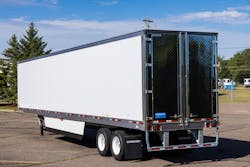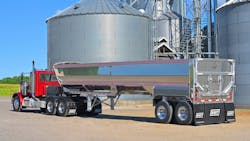Fleet managers and executives must always be aware of where the industry is heading in terms of what equipment and technology are available and how to maintain them. This, however, hasn't been easy with all the changes, advances, disruptions, and supply shortages in the last few years.
“It’s definitely a very dynamic market that we’re living in right now,” noted Nick Clinkenbeard, product manager of dry and refrigerated vans at trailer manufacturer Wabash. “And if you had a good way to predict where it’s going in the future, that’s a crystal ball that I think a lot of people would pay a lot of money for.”
Since the spring of 2020, trucks, trailers, and tires have all been more difficult to come by. Raw materials and components such as semiconductors became harder to obtain, and plants shut down to stop the spread of the pandemic. This led to mounting backlogs and trucks waiting for repair parts.
For the foreseeable future, however, manufacturers are feeling a bit of relief. “The long delays are pretty much behind us,” Clinkenbeard said on behalf of Wabash.
But what about the rest of the heavy-duty trucking industry? One way to better predict where the industry is headed is by looking at the overall economy. Inflation was at record highs until recently, and the Federal Reserve raised interest rates to 4% in November, the sixth straight increase.
“I just don’t see how we avoid a recession,” pondered Bob Costello, American Trucking Associations’ chief economist, at Isaac Instruments’ 2022 User Conference. On the bright side, he did add that the recession “should be relatively short; it should be relatively mild.”
See also: As recession concerns rise, driver shortage figures stall
Truck outlook
So, how will the amount of new Class 8 trucks on the road in 2023 be impacted by the current economic situation? After non-vocational Class 8 truck sales rebounded from 168,600 in 2021 to 198,800 in 2022, next year they will dip 12.4% to 174,000, according to ACT Research’s market data.
“For now, business activity in the truck industry rolls on, seemingly unfazed by higher interest rates,” said Eric Crawford, VP and senior analyst at ACT Research. “That said, we expect this dynamic to shift in [the first half of FY 2023], as the Fed continues its aggressive push to subdue inflation. Cracks in the economy are becoming more evident: The impact of higher rates has begun to slow activity in the housing sector, and large layoffs have started in the tech sector.”
See also: ACT: Strong pent-up demand in Q4 for Class 8 trucks
He recommended customers select “ever more aggressive—or lower—rear axle ratios, which keep engine rpms lower, requiring less fuel to do the same work.”
Daimler Truck North America, which makes the market leader Freightliner (40% share), noted several external forces will impact the market.
According to the company:
“The company’s outlook is especially subject to the further developments in the Russia-Ukraine war and its impact on the global economy as well as the development of the very high inflationary pressure and the associated central-bank increases in interest rates.The further macroeconomic, geopolitical as well as the COVID-19 pandemic development and ongoing supply bottlenecks, also harbor an exceptional degree of uncertainty. However, Daimler Truck assumes no major production downtimes due to missing parts or due to the unavailability of gas.”
Fuel may be available, but it is expensive.
“Likely due to fuel prices, on-highway customers are gravitating toward down-speeding through integrated drivetrains at an accelerated rate,” offered Len Copeland, product marketing manager for DTNA’s Detroit brand.
Copeland noted hardware such as Detroit’s Axle Lube Management can “offer immediate fuel savings with no driver interaction whatsoever.”
Over at Volvo Trucks North America, the order board is “healthy” with sales at market level, explained Johan Agebrand, director of product marketing. Agebrand also reported “seeing significant improvements in the semiconductor and transport restrictions that we—from a global perspective—ran into in the economic recovery from the COVID pandemic. The current situation we are seeing is now more in relation to labor and capacity restrictions since the economic environment has recovered.”
On the trends front, fuel efficiency has been more of a focus to Volvo customers, Agebrand said, because of fixed contract rates and decreasing spot rates.
“When the spot rates were increasing due to a shortage of transport capacity, the increase in fuel price in some sense was lost in the increase in transport rates,” he explained.
Volvo customers who spec a turbo-compound engine and I-Torque powertrain combination will have the flexibility to adjust to speed or fuel efficiency needs, “without sacrificing overall fuel economy,” Agebrand said.
Overall, a fleet that keeps up with regular maintenance according to OEM recommendations will prevent unexpected downtime and keep trucks moving and generating revenue, Agebrand said. Investing more time into training drivers will also yield a good return.
“The driver and how they utilize the truck is the biggest operating cost impact for any fleet,” he said. “Good drivers versus bad drivers can easily have a 10% operating cost difference.”
Navistar's International experienced a healthy 2022 and expects continued momentum into 2023 while navigating various component shortages and production challenges, reported Chet Ciesielski, VP of on-highway heavy-duty truck business. “Our strong order intake has created a very strong backlog,” he added.
The company has seen supply chain improvement but does “continue to work through challenges,” Ciesielski ceded.
The International S13 Integrated Powertrain, which starts production in 2023, will provide customers with some relief. With the S13, the latest International LT Series will have 15% better fuel efficiency than one with a first-generation International A26 engine. CEO Mathias Carlbaum said this will be the final new internal combustion engine developed by International.Ciesielski added that maintenance efficiency can be improved by leveraging OnCommand Connection connected vehicle solutions. The various features help optimize maintenance (Advanced Predictive Maintenance), reduce unplanned repairs (Fleet Health Monitoring), and drive service event efficiency (International 360).
Fleets are also adopting more advanced driver assistance systems to prevent nuclear verdicts, Ciesielski added.
That’s a trend also recognized at Paccar Leasing, which rents and leases Kenworth and Peterbilt trucks and provides maintenance.
“Among our larger fleet customers, we’ve seen a material increase in the demand for refined driver performance and safety systems to be added to the vehicles, including adaptive cruise control, collision mitigation systems, lane departure warning systems, and side object detection,” said Eric Hruby, PacLease director of operations.
See also: New commercial vehicle breakthroughs offer big advantages
PacLease also reported an accelerated adoption of integrated powertrains and automated manual transmissions, which Hruby said are sought after for driver retention and fuel efficiency benefits.
“Over the last 18-24 months, PacLease has seen more than an 80% take-rate for integrated powertrains and [automated manual transmissions] among our longhaul customers and more than 90% in the regional haul segment, an increase of roughly 20% and 15% respectively,” Hruby said.
While efficiency is in higher demand, uptime still reigns supreme.
“If I were to reference a common theme among our customers in today’s lease and rental industry, maximizing uptime is on everyone’s agenda,” Hruby said.
Telematics and other smart technologies have helped PacLease customers with uptime. Paccar Connected Truck and Paccar Solutions provides customers access to remote diagnostics, over-the-air updates, and service management portals that allow them to track live truck performance and health.
“Remote diagnostics allows us to see any issues with a truck in real-time,” Hruby said. “This way, we can determine when and where the truck should be serviced, allowing our customers to realize more uptime.”
Keeping up with maintenance is even more important as the industry overall contends with aging trucks. In both 2020 and 2021, the average trade cycle was 8.7 years, according to American Transportation Research Institute (ATRI). That’s the highest in a decade.
“The longer a fleet waits to replace their aging equipment, the more it can compound the financial burden of unscheduled maintenance events and downtime at higher repair costs and potentially longer service times,” Hruby said.
Trailer outlook
On the trailer side, ATRI reported that the average trade cycle stretched from 12.3 years in 2020 to 15.4 in 2021, excluding flatbeds and intermodal chassis. Those older trailers can only provide adequate service to fleets for so long, though, and 2023 could see a bigger spike in fleets adding new trailers.
“The age of fleets is trending up, and they’re wanting to get those [trailers] replaced,” Wabash's Clinkenbeard said.
This has led to strong orders overall. In 2021, trailer orders were just shy of 250,000 units. In October 2022, FTR Transportation Intelligence forecasted this year would hit 303,000 trailer orders, with a 7% increase to 325,000 next year.
Wabash has seen some improvement in delivery over the recent months, Clinkenbeard explained, and the company’s record Q3 revenue of $655.2 million backs that up. The Lafayette, Indiana-based company’s net sales increased 35.8% over Q2, and total backlog was at $2.3 billion as of Sept. 30, up 20% over Q3 2021.
See also: Trailer orders keep soaring in November on strong demand
These new trailers are a lot smarter than their replacements, which, at 15-plus years, would pre-date the smartphone boom. And now fleets can take advantage of the trailer connectivity increase by spec’ing cargo sensors and trailer telematics devices when they order them.
“With our customers, the data analytics side has grown exponentially over the last few years, and we’re definitely seeing a lot more activity in that space,” Clinkenbeard said. “The way of the future is more connected assets and better visibility to your assets and how they are performing so that you can plan for maintenance rather than have the roadside calls that are costly and disruptive.”
Hyundai Translead also holds a positive outlook for 2023 “due to pent-up demand.” It also agrees that smart trailers are the way of the future.
“New technology continues to become more commonplace—there are steady increases across the industry in most items that will help reduce maintenance, increase fuel savings, or provide useful data to a customer operation,” Sean Kenney, chief sales officer at Hyundai Translead, said. “GPS has essentially reached 100% adoption, while accessories that go along with GPS (cargo sensors, door sensors, solar panels) have become a much more common sight in the last two years.”
He added ATIS has seen steady growth, while air disc brakes and TPMS “are also gaining steam and garnering more interest with passing time.”
Because of fuel prices, aerodynamics devices could end up being adopted by “a large majority” of customers, Kenney said.
As far as smart hubs and zero-emission reefer units, these technologies just improve their efficiency rate to become cost-competitive.
“From a fleet perspective, the necessary infrastructure must be in place to utilize new technology and how quickly existing TMS software can manage the new system or environment,” Kenney explained. “It is expected that the use and application of these new technologies will be adapted to the truck/trailer industry in the near future. The time it will take will be decided on whether the needs of both supplier and user are met.
David Giesen, VP of sales for Stoughton Trailers, said shortages from component manufacturers may continue through next year, though.
“The overall industry responded as good as could be expected with all the barriers that were put in place,” he noted. “OEMs are maximizing what they can build given the constraints. Next year looks a lot like the current year.”
Stoughton Trailers has taken measures internally to ensure its trailers last longer for customers. To maximize trailer life and prevent corrosion, Stoughton started galvanizing “almost all painted components,” Giesen said.
East Manufacturinghas also experienced longer lead time, according to Chris Cooler, VP of sales and marketing, but that had minimal impact on the customer.“We have had a few isolated instances where we did not receive materials in time for production causing us to red tag a handful of trailers,” Cooler said. “However, our close relationships with our vendor partners have kept these situations to a bare minimum.”
East has employed measures since the pandemic to ensure it also has the people to assemble the trailers as well. These include labor rate increases, sign-on bonuses, referral bonuses, numerous employee appreciation events, modified pricing strategies, allocations, and more.
“We anticipate that many of these programs will be left in place through 2023,” Cooper said.
Like the rest, Cooper found TPMS and ATIS have been more adopted the past few years, though not at a significant rate. East does predict trailer telematics and other smart trailer technology will “grow dramatically in the coming years,” Cooper added.
This article originally appeared on FleetMaintenance, one of FleetOwner's sister sites, as a three-part series on heavy-duty equipment trends.







